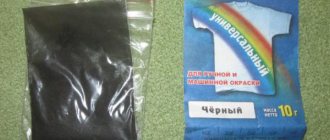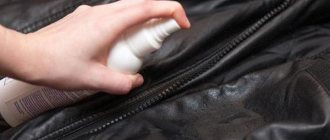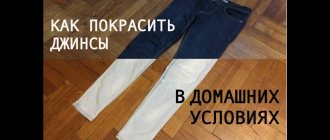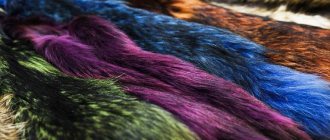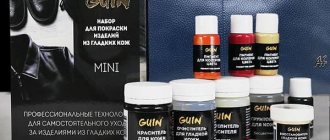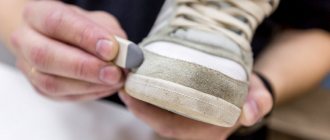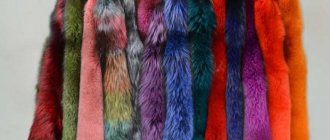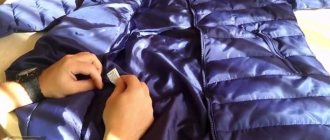Leather is the most wear-resistant material and can be worn for decades. If you fall in love with an item, you won’t be able to throw it away, and the price of a new purchase can be steep. There is only one way out - try to update and transform leather products with your own hands. Things will get a new life, but the effect will not be the same as with factory painting.
Skin coloring methods
There are 2 methods of dyeing leather items. For deep dyeing, the product is completely immersed in the dye solution. Leave the item for several hours, then take it out. The dye covers both parts - front and back.
In surface painting, the dye is applied with a brush, sponge or spray paint. Apply the coloring matter from top to bottom with a brush. This coloring allows you to paint only the face of the product. To carry out the work you need dye, a large container of water, as well as salt and vinegar essence. The leather must be clean before painting.
Dyes and their features
As noted above, there are four leather dyes. Regardless of the composition, they have their own characteristics for applying and drying things.
Aerosol
One of the most popular dyes for leather products. It is recommended to use it in open spaces with a respirator. This is necessary to avoid inhaling hazardous aerosol substances.
- The dye is applied at a distance of 25-30 cm from the object.
- At the same time, you should not pay much attention to one area, so as to avoid uneven coloring.
If drips are detected, they are removed with a cloth or sponge.
Cream paint
It is sold in special packs. Before use, pour it into a bowl and apply with a dry sponge. It is important here that the same layer of paint is applied to each defect.
- A denser layer is applied to decorative elements, seams and places near locks.
- Dry naturally.
- And after a few hours the painted product is used.
Powder with coloring pigment
This product is used after dissolving in water. Not so popular with buyers. Because even the slightest undissolved grain can get on the skin and cause irreparable harm to it.
Therefore, before using the powder, it is recommended to strain its solution through a sieve. And only after making sure that it is uniform, use it for work.
Liquid dye
Somewhat reminiscent of the above option, but used more often. Having some nuances of application. The first thing they do with the item to be painted is soak it in clean water for a couple of hours. In the meantime, dilute the dye in the liquid, taking into account the instructions in the instructions. The item is then pulled out of the water and moved into the coloring pigment.
And leave it for the period specified in the instructions, not forgetting to turn it over periodically. When all the steps are completed, the item is taken out of the dye, rinsed thoroughly with water and dried naturally.
Also, in order for the paint to last longer, it is recommended to fix it. This is done in two ways. The first is to purchase a purchased product.
Or the second option, the solution is prepared as follows:
- Take 1 liter of water, mixing it with 2 s/l. salt and 100 gr. vinegar. Mix everything thoroughly;
- Dip the product into the solution, rinsing it a couple of times;
- Dry the product naturally.
And another way to fix the dye is to wipe the surface of the object with a weak solution of vinegar. And also dry it.
Painting leather at home is the best method if the item is black or you want to save your family budget by postponing dry cleaning services.
How to paint a leather jacket
It is not difficult to dye leather at home. Before work, you need to find out what condition the product is in and how it was tanned. If the cut is pink and white, then the tanning is vegetable. With a blue-gray cut, chrome plating took place at the factory. The front side of the leather is covered with a protective film to repel moisture. When painting a house, such a film will not allow you to paint the material well. It is removed with a solvent. It is important that the item is cleaned and washed. It is easier to apply paint to a clean jacket and it will color better. Wipe the item with a damp, but not wet, cloth; first soak the cloth in soapy water. The jacket is wiped thoroughly, the entire surface.
Leather paint (description, use)
Type 1
Title: "Renia"
Country of origin: Italy (we purchase directly from the supplier)
We have been supplying this type of paint for more than 4 years; everyone who previously bought paint from us dealt with it.
Description: Professional paint for leather, with strong coloring properties, deep penetration (no crust effect!), transparent (will not change the color of a dark skin tone into a light one!), suitable for things with intense use and friction (belts, bags, gloves, etc. ). The paint is based on a solvent, so painted items are not afraid of water. The effect is “natural”, that is, whatever shine the skin had before coloring, after coloring it will completely retain it (since the paint is deeply absorbed). Designed for all types of natural leather (it will not be absorbed into coated haberdashery leather). Suitable for both full leather dyeing and painting.
Method of application: You can apply the paint with a brush, swab, piece of wool, or sponge. The number of paint layers is from 1 to 6-8 (it all depends on the color intensity you need). Immediately after use, wash the tool twice with warm water and soap, dry it moderately with a towel, and leave it to dry completely in its natural environment (if you forget to do this right away, the paint will dry out and the tool will be almost impossible to wash).
Features: This paint has the peculiarity (especially on vegetable tanned leather) of not immediately showing the color you will get, so we recommend applying the first coat of paint and waiting 6-10 minutes, and you will notice how the color can change a lot (at first it may even seem dirty, and the color is not so clear, but this is all due to the process of absorption of paint into the skin), and then apply subsequent layers, also waiting for time. When you have chosen the desired tone, complete drying of the product takes no more than 1 hour.
We also want to note that in jars, all colors of paint may seem black, but this is not so, just check it “against the light” and everything will immediately become clear (tilt the jar in the light so that it glass inside the jar, and the color will immediately be visible ).
Expense: This is a very specific question that we are asked, but, unfortunately, there is no clear answer to it. Leather is very different, some absorb moisture well, some not so well, whether it is vegetable tanned or mixed, these are very significant factors for answering the question of consumption. But if you take and average all the possible options and speak very roughly, a 100 ml bottle is enough for 4-6 vegetable tanned leather briefcases.
*There is no white in this color range! The paint is completely transparent
Type 2
Title: "Renia"
Country of origin: Italy (we purchase directly from the supplier)
This is a new type of paint from our manufacturer, which does not come around very often and we previously purchased it extremely rarely, so for many, this paint may be new.
Description: Professional paint for leather, with a strong coloring property, is also absorbed, but has a denser texture, i.e. the lower layers of paint are absorbed into the skin, and the top leaves a light film (not peeling off), because of this the paint is more opaque, unlike type 1, but still it is translucent (it will not change dark skin tone to light!). The paint is based on a solvent, so painted items are not afraid of water. The effect is “moderate shine,” that is, the skin after coloring acquires a slightly greater shine (the shine is not flashy, but moderate). Designed for all types of natural leather (it will not be absorbed into coated haberdashery leather). Suitable for both full leather dyeing and painting.
Method of application: Similar to type 1 paint
Features: In relation to the 1st type of paint, the 2nd type picks up tone faster due to its denser texture (due to this factor, you can immediately understand the tone in bottles of this paint). Almost all colors are painted according to the scheme - a layer of paint - 2-4 minutes - a layer of paint. But there are “capricious shades” and they, like type 1, need to be allowed to dry between layers for 8-10 minutes. When you have chosen the desired tone, complete drying of the product takes no more than 1 hour.
Consumption: Same as 1st type of paint
* This line comes in white, but layers take longer to dry. Wait 15-20 minutes between layers, when you have reached the desired tone, complete drying of the product - no more than 8 hours.
!!! I would like to draw your attention to the fact that before use you need to try the colors on a separate piece of leather; the paint may behave differently (in terms of absorption, number of layers, brightness of the resulting tone, etc.), even the “native” skin tone itself, can contribute to the final result. This leather paint is not acrylic, it will not cover any defects (cuts, scratches, etc., for this you need to look for liquid leather), it will NOT form a cracking crust.
If you have any questions/problems while using it, please write, we will always try to help you.
*Since the paint is solvent-based, it is not afraid of frost, but we still recommend letting it sit and warm up to room temperature before starting work
** You cannot buy a solvent (thinner) for this paint, because it is not available in Russia (e6000 base) and the manufacturer does not allow any dilution of this paint. The paint must be stored in a dry, dark place. With the lid tightly closed, the paint will not evaporate or disappear, so that there is a need to dilute it, as some ask. The paint can dry only in one case - you have not closed the lid tightly.
Painting leather at home
You can dye leather with affordable and cheap aniline dyes; they are used to dye fabrics. Choose paints for wool fabric or universal ones. Dying mixtures for cotton are less saturated, the effect will be worse. If there are paints from the same company, but in different tones, they can be mixed to create the desired shade.
When applied deeply, acid dyes are used that penetrate deep into the skin. Vegetable paints and those that can be prepared at home from available substances are widely used.
Aerosols are used for surface painting. The product is placed in the fresh air. Be sure to wear a respirator, protective clothing and gloves and spray the substance. Nitro paints are applied to dry skin using a brush or sponge.
Natural dyes that give a brown color: apple and oak bark, ground acorns, walnut shells. The leaves and stems of celandine, alder bark, buckthorn, and henna give red colors. For green shades, choose willow bark, bird cherry, aspen wood, and nettle. Golden tones are obtained using onion peels, loose leaf tea, and horse chestnut rhizomes. Basma colors the material from gray-black to dark green.
The pharmacy sells medications that can stain the skin: potassium permanganate or iodine (brown), brilliant green (green), fucorcin (raspberry). The stain helps achieve a light brown tone. Gray tones are obtained using iron sulfate. Soda and potash give a red-brown color.
Important! Before applying any dye, first check its effect on an inconspicuous area of the skin, and then dye the entire thing.
Restoration of leather goods
Quite often, genuine leather products are damaged. These may be cracks, scratches or cuts. Deep tears are not easy to repair, but scratches can be repaired.
The product can be restored using a special composition called “liquid leather” or restoration paste. This material must be applied by hand using a small putty knife or your own hands. Liquid skin is squeezed onto a sheet of paper and applied to the damage in small portions.
For example, repairing a leather jacket occurs as follows. The damaged surface is wiped with a dry cloth, then a small portion of liquid leather is applied to the scratches. After this, the paint is pressed manually using plastic gloves. Only to such gloves the composition does not stick during work.
The liquid leather is then dried with a hairdryer and pressed again by hand. Layers are applied until the defect is eliminated. After each application, the layer must be heated with a hairdryer and pressed manually.
If a build-up forms, it can be easily removed with fine sandpaper after the layer has dried. Next it is painted with topcoat paints and polished with a rag. Separate finishes are not used,
Homemade paints
At home, rusty nails, coffee, tea, potassium permanganate, iodine, berry juices and other household substances are used for painting. For the experiment to be successful, you need to observe the proportions of the substances and the painting time.
Nails and vinegar
The leather is dyed black using vinegar and rusty nails. Hot vinegar is poured into a plastic bowl (the dose depends on the density of the color). For 2 liters of vinegar essence, at least 40 large rusty nails or any rusty objects of the same quantity are required. Before the procedure, the iron is washed in an alcohol solution to degrease. The product is left for 15 days. If the metal is not rusty, then the solution is infused for 3 weeks. The composition will be ready when the smell of vinegar disappears. The coloring mixture is filtered several times.
Edge processing tools
Each master has his own set of tools, but usually the basic set includes standard items.
What tools are needed for leather processing:
- Edge cutter - helps to remove a chamfer from the edge (a couple of pieces with different diameters and different sections are enough for a novice craftsman). Don't forget that edgers need to be sharpened from time to time.
- Creaser - heated on a burner, after which they need to go along the edges of the product. It will leave a beautiful line, slightly melt and round the edge.
- An engraver is useful in different types of work, in this case it will align the ends with sandpaper on a wheel.
- Chemical compositions – Toconol, hard wax, etc. Primer, paint - there are a lot of options, each master chooses for himself. It happens that you have to turn to glue.
- Sandpaper of different grits. Without abrasive, it is impossible to achieve an ideal result.
- Slicker. Tools for finishing leather. To put it simply, he polishes it.
Other tools and means are optional. You will also have to experiment with paint; any first job, in principle, is a trial step. As you go along, you will understand how it is easier for you to process the edges.
We recommend reading: Be your own designer - how to quickly and competently make a handmade belt from genuine leather
Handy products for painting eco-leather
Eco-leather differs from genuine leather in that its base is polyurethane. The remaining components are natural. The material is used for the manufacture of furniture upholstery, accessories, clothing, and shoes. As with leather, natural dyes, aniline dyes, and silicone spray are used.
Spray with silicone helps to distribute the paint evenly over the entire surface of the material. A protective film is formed, which gives the eco-leather additional resistance. The products are colored and colorless. They color eco-leather, serve as additional protection, add shine, and increase wear resistance. The dyeing process is the same as for natural leather.
What is the advantage of paints?
This method of restoring the aesthetics of a leather interior has certain advantages, sometimes considerable ones. The obvious advantages of car leather paint include:
- Efficiency – complete restoration of all elements may take a maximum of 2-3 days. Compared to sheathing, this process takes two weeks.
- Dramatic changes - painting the interior trim allows you to change its color. Therefore, if you don’t like the old skin tone or are tired of it, you can easily replace it with a new one.
- Technology - thanks to the observance of elementary technology, the new layer will hide the old coating from view, which will significantly transform the interior of a leather car.
- Preservation of material – application of paint and varnish material (LCM) does not harm the surfaces of the car.
- Convenience of work - all the work can be done by any machine owner, without the help of specialists.
- Reasonable price - the cost of paints for the leather interior of a car is much lower than the cost of reupholstery.
Ready-made paints
For leather products they produce “Extra” paint, nitro enamel, Enamel NTs-36, Viva Color Up. Rainbow ink is also used. Castor oil is added to any nitro paint. The first layer is primed with paint diluted in a solvent 1:3. The next two layers are painted with undiluted dye. Between stains, allow the material to dry for about 60 minutes, but not dry completely.
Well-known companies that produce high-quality paints and skin care products: Salamander, Silver, Cavallo, Platinum, Twist, Selton.
If you need an exotic color or pattern, you can use oil paints for painting. They are not applied in places where there are kinks, they will crack. The products take 3 days to dry.
To obtain a tint, use creams for leather items: Sochi, Karat, Polish and others. Natural suede is surface dyed with dissolved aniline dye. Purified and distilled water must be used. Use a stiff brush to pass over the suede surface.
Paint it yourself, or hire a professional?
Before handing over a leather product to a repair and restoration workshop, it is necessary to assess the possible risks. To do this, you can ask close friends and acquaintances if they had to give things to the chosen workshop and what the result was.
To dye leather yourself, you will need to be patient and purchase the necessary tools and paint. There is a wide choice of types of dyes for natural leather.
So, for example, an oil- or water-based leather product is suitable for painting a leather jacket. As a result, oil paint will make the product denser and harder, while water paint, on the contrary, will soften the texture of the material and preserve its natural properties.
Creation of vegetable dyes
If you combine oak bark with onion peels, tea or coffee, you can get different shades: golden, nutty, chestnut, brown with a reddish tint. It all depends on the concentration of the substance - the more bark, the darker the tone.
Oak decoction:
- 100 g of bark is poured with 2 glasses of water;
- boil for at least 30-40 minutes;
- allow to cool, filter the liquid;
- immerse the product for 2 hours, the time depends on what tone is needed, the longer it is kept in the broth, the darker the color;
- rinse, grease and cream.
Oak with coffee:
- pour 4 tablespoons of bark and 2 tablespoons of coffee into the bowl;
- pour 0.5 liters of boiling water;
- simmer over low heat for 20 minutes;
- filter, the dye is ready.
Tea with oak bark is prepared in the same way as the previous recipe. For 2 tablespoons of bark, a spoon of large-leaf black tea and 200 ml of water. For onion broth you will need 4 tablespoons of bark, 2 tablespoons of onion peel and 400 ml of water.
Oak bark with henna (2:1) gives red tones; henna is often used as an independent dye. To get a fiery shade, elderberries, beet juice, wolfberries, and buckthorn are added to henna. Red with purple is a combination of henna and red marshmallow flowers. Golden shades are obtained with the addition of chamomile, rhubarb, and saffron.
Popular brands
Everything is clear when choosing the type of paint for car leather, but what about brands - there is a whole variety of them? The most popular manufacturers of products for painting car interior leather are the following brands:
- Salamander Professional Leather. This is an aerosol dye. Contains lanolin, which protects and nourishes the skin. The pigments included in the composition increase the color intensity and provide excellent shine. Refreshes color and covers worn areas, provides care and protection. Convenient to paint large surfaces
- Liquid Leather. Ideal for any type of natural or artificial leather or suede. You can apply it as conveniently as possible - with a brush, sponge or pour it into a spray bottle. Durability is even longer - 7 years.
- Saphir. This is also another type of “liquid leather” for the car interior, which is suitable for eliminating large defects. With its help you can completely restore the shade.
- Twist Fashion. Aerosol version, so painting is carried out evenly, without streaks and stains. Does not contain ozone depleting substances. Thanks to Jojoba oil and fluorocarbon resins, the paint protects the surface well from moisture, salt, and snow.
- Motip. High-quality acrylic solution, which is intended for painting interior trim elements made of artificial or natural leather, as well as plastic and vinyl. The product is characterized by high elasticity, which protects the surface from delamination and cracks. The compositions are supplied for sale in 150 ml bottles and in different colors - green, turquoise, yellow, white, red, black, beige, blue, gray.
Tips for dyeing leather
For painting, choose a room with good ventilation; many compositions have a pungent odor. Before work, the work area must be covered with polyethylene or paper. The leather material is fixed with tape.
Adviсe:
- Be sure to use protective equipment: rubber gloves, a respirator.
- Prepare in advance sponges, brushes, spray bottle, solvent, oil mixture, paint.
- Take into account the thickness and type of skin. The thick belt is tinted, and the gloves are dyed right through.
- Turpentine or gasoline removes grease stains.
- Wax for leather shoes will easily remove scuffed areas on the product.
- Thin, soft leather should not be subjected to aggressive cleaning before dyeing.
After use, the branded dye can be poured into a jar. The name and color of the paint are pasted on it, and the date of manufacture is written. The product is stored for several months.
How do you like the article?
Recommendations for saving the result
The use of the considered products for coloring leather chairs or other elements gives good results. This procedure helps restore the integrity of the coating, and the material regains its lost softness and elasticity. The effect of coarsening and shrinkage is eliminated.
But so that the work done does not turn out to be a waste of time, it is necessary to follow basic recommendations in order to prolong the restoration effect of painting.
- You should not transport animals on car seats, as their claws can damage the finish. Dogs and cats should be transported in special cages or use another vehicle.
- Objects with sharp corners and edges should also not be transported in the car. There is a luggage compartment or delivery service for this.
- If you need to chemically clean the interior, you should use products without aggressive components.
- If you use your car intensively, you should purchase a driver's seat cover. This measure will protect its upholstery and avoid scuffs.
Following these simple tips will allow you to enjoy the appearance of your car's interior for a long time.
How to choose eyebrow dye?
The choice of dye is influenced by a large number of factors, ranging from natural hair color to what type of skin the client has. The paint itself adheres well to the hairs, and the imprint on the skin is washed off, as a rule, 4-5 days after the procedure.
There are several fundamental factors for choosing paint during the procedure:
- Analysis of the initial state of the eyebrows.
If the hairs and skin around the eyebrow area are a bit dry, we do not recommend using henna as a dye. Synthetic dye (paint) has a more gentle effect.
- Hair structure.
The dye is suitable for almost any hair structure. It works especially well on soft, thin and dehydrated eyebrows.
- Shade of hair on the head and eyebrows. Coloristics.
Depending on the tone of the hair and the initial condition of the eyebrows, a suitable dye color is selected.
- Girl's skin type.
The paint works great with any skin type.

